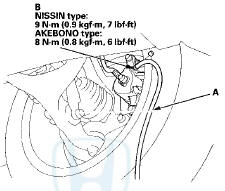 Honda Accord: Brake System Bleeding
Honda Accord: Brake System Bleeding
NOTE: - Do not reuse the drained fluid. Use only new Honda DOT 3 Brake Fluid from an unopened container. Using a non-Honda brake fluid can cause corrosion and shorten the life of the system.
- Make sure no dirt or other foreign matter gets in the brake fluid.
- Do not spill brake fluid on the vehicle; it may damage the paint. If brake fluid does contact the paint, wash it off immediately with water.
- The reservoir connected to the master cylinder must be at the MAX (upper) level mark at the start of the bleeding procedure and checked after bleeding each wheel location. Add fluid as required.
1. Make sure the brake fluid level in the reservoir (A) is at the MAX (upper) level line (B).

2. Have someone slowly pump the brake pedal several times, then apply steady pressure.
3. Start the bleeding at the driver's side of the front brake system.
NOTE: Bleed the calipers in the sequence shown.
BLEEDING SEQUENCE

4. Attach a length of clear drain tube (A) to the bleed screw (B), then loosen the bleed screw to allow air to escape from the system. Then tighten the bleed screw securely.
NOTE: The illustrations show the NISSIN type.
Front

Rear

5. Refill the master cylinder reservoir to the MAX (upper) level line.
6. Repeat the procedure for each brake circuit until there are no air bubbles in the fluid.
 Parking Brake Inspection and Adjustment
Parking Brake Inspection and Adjustment
Inspection
1. Pull the parking brake lever (A) with 196 N
(20 kgf, 44 Ibf) of force to fully apply the parking brake.
The parking brake lever should be locked within the
specified number of clic ...
See also:
Dashboard/Steering Hanger Beam
Disassembly/Reassembly
Special Tools Required
KTC Trim Tool Set SOJATP2014*
*Available through the Honda Tool and
Equipment
Program; call 888-424-6857
NOTE:
- Put on gloves to protect your hands.
В© Take care no ...
Waive Guide Replacement
Special Tools Required
Valve Guide Driver, 5.35 x 9.7 mm 07742-0010100
Valve Guide Reamer, 5.5 mm 07HAH-PJ7A100
1. Inspect the valve stem-to-guide clearance (see page
6-88).
2. As illustrated, ...

